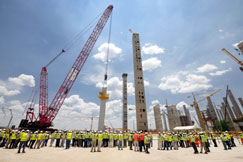South Africa will not privatise Eskom
15 May 2015
Minister of Public Enterprises Lynne Brown has ruled out the privatisation of basic
services, such as the provision of electricity and water, and has said load shedding
will continue for three more years.
Until the "end-state" of Eskom was clarified "we can't say what parts should go
where", said Brown, who was speaking at a media briefing ahead of her budget
vote in the National Assembly on 14 May.
Reuters reported on 13 May that South Africa was considering either partially
privatising Eskom or putting up some of its assets for sale in order to secure
funding for the power producer and resolve an energy crisis.
Quoting a statement from the National Treasury, it said South Africa was
considering ring-fencing and selling stakes in the state power utility as it sought to
secure funding for the power producer and resolve an energy crisis.
"Given Eskom's constrained balance sheet and government's constrained fiscal
position, there is a need to explore all options," the Treasury said. "Consideration is
being given to ring-fencing and selling stakes in Eskom's non-core businesses or
power stations as well as into Eskom's business as a whole."
However, Brown was emphatic that she did not believe one should change the
state-driven ownership model "for now… until you know what you are working
towards. You can't make a decision [about] what happens to Eskom or any of the
other state-owned companies [until then]".
My long politician's answer
Turning to what she called "my long politician's answer", namely the question of
what could be privatised by the state, Brown said: "Basic services must be provided
by the state. How private companies and the private sector interact with that is part
of what we are trying to do now. [But] we must be able to remain in charge as a
state, for want of a better word."
Turning to the troubled Eskom, Brown said that
even "in the deepest difficult time"
– apparently referring to load shedding – Eskom had been able to connect 160 000
households with electricity.
"It [Eskom] can’t be driven by capital… or profit," she said, noting that it was the
state's responsibility – through Eskom as a commercial venture – to carry out the
developmental responsibility.
While acknowledging that load shedding would continue for the next three years,
the minister said that some Eskom achievements "seemed to have been lost in the
avalanche of publicity about other matters".
"Today, I am very pleased to announce that the ramp-up towards full output at
Medupi has passed the 700MW milestone. When fully operational by the end of June
2015 as promised, it will deliver the equivalent of more than 40% of the output of
the Koeberg Nuclear Power Plant."
Scheduled maintenance of Koeberg's Unit One was well on track and was expected
to bring more than 900MW back to service by the
end of May.
Eskom build programme
"Looking ahead I have tasked the leadership of Eskom to accelerate the completion
of the build programme, with improved project management, contracting and
increase the generation capacity of the existing fleet," Brown said.
The state-owned companies under her department – Eskom, Transnet, Denel, South
African Express, Safcol and Alexkor – had combined annual revenues of over R200-
billion, she said, and would contribute the lion's share of the state's investment in
infrastructure of more than R330-million a day every day over the next three years.
"In conclusion, I want to say that over the next five years the highest priority goals
which the department and I are required to drive are set out in the National
Development Programme-rooted Medium-Term Strategic Framework. Foremost
among these are critical initiatives to lower the cost of doing business to stimulate
job-creating growth and to increase
the efficiency of the economy:
- First, ramp up the electricity generation reserve margin from its current levels
to 19% by 2019;
- Second, increase the tonnage moved on rail from the current 207 million tons
to 330 million tons by 2019;
- Third improve the operational performance of sea ports and inland terminals by
increasing the average gross crane movements per hour by 25% by 2019; and,
- Fourth, use the Eskom and Transnet infrastructure development and
replacement investment spend to drive the overall national investment rate to 25%
in a way that crowds in private sector investment and creates opportunity for new
suppliers and sectors."
Source: SAinfo reporter and News24Wire
 Rainbow over electricity pylons in South Africa's Free State province (Photo: Chris Kirchhoff, MediaClubSouthAfrica.com)
Rainbow over electricity pylons in South Africa's Free State province (Photo: Chris Kirchhoff, MediaClubSouthAfrica.com)
 Early construction on the Medupi power station in Lephalale, Limpopo province (Photo: Hitachi Power Europe GmbH)
Early construction on the Medupi power station in Lephalale, Limpopo province (Photo: Hitachi Power Europe GmbH)





